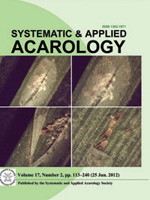The Carpoglyphidae is a small family of two genera and six species (Schatz et al. 2011) and five of the species are in the genus Carpoglyphus (Clark et al. 2010). The dried fruit mite, Carpoglyphus lactis L., has received renewed interest in recent years due to its role as an alternative food for predatory mites in the Phytoseiidae that are used in biological control (Baxter et al. 2011). In New Zealand, there has been interest by the biocontrol industry to import this species into New Zealand for mass-rearing of predatory mites. However, there has been some confusion about the presence of this species in New Zealand. In this short note, I clarify its nomenclatural status and also its New Zealand records.
Nomenclatural status. This species was credited to Linnaeus, 1758 by many authors (e.g. Hughes 1976; Fain & Rack 1987; Hubard & Fashing 1996; Fan et al. 2010), and also to Linnaeus 1767 by others (Halliday 1998; Sirvid et al. 2011). A check of the original texts of Linnaeus (1758, 1767) confirms that it is the latter (see Fig. 1 below).
FIGURE 1.
Page 1024 of Linnaeus 1767 where Acarus lactis was described after Acarus siro (see full open-access book http://biodiversitylibrary.org/bibliography/37256).

New Zealand records. The first record of Carpoglyphus is for an unnamed species (Findlay 1921). Spain and Luxton's (1971) mite catalogue of the New Zealand subregion missed this early record, but included an un-identified species of this genus from Macquarie Island (Watson 1967). Nomenclatural reference book (Ramsay 1980) and text book (Waller 1984) list C. lactis from New Zealand, although these records are neither referenced to primary literature, nor linked to voucher specimens. Fan and Zhang (2007: 62 & 66) gave the first verified report of C. lactis in mainland New Zealand based on specimens collected in 1962 by R. Wilson from bee frames in Christchurch and by an unnamed collector in 1955 from Rattus rattus in Wellington (specimens preserved in New Zealand Arthropod Collection). Bingham (2007) reported two specimens of C. lactis from 22 New Zealand honey bees sent to MAF (now succeeded by Ministry for Primary Industries) Biosecurity New Zealand's Investigation and Diagnostic Centre (IDC) in Wallaceville. He noted that this species was among those “regularly found in samples from MAFBNZ's apiculture surveillance programme”. Clark (2010) also studied C. lactis from samples collected by IDC (Christchurch) from the apiculture surveillance programme. The author also recently examined specimens collected from New Zealand honey bees during the apiculture surveillance programme (specimens preserved in IDC Auckland). These multiple records based on specimens collected from 1950s to the present in different areas indicate that this species is established in New Zealand.
Acknowledgements.
I thank Rosa Henderson (Landcare Research) and Xiaoyue Hong (Nanjing Agricultural University, China) for reviews and comments, and Disna Gunawardana and Olwyn Green of IDC (Auckland) for assistance with the loan of IDC specimens.





